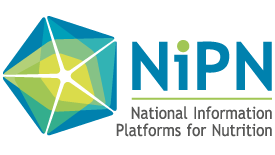Setting up a Multisectoral Advisory Committee: an Ethiopia case study
Context
Ethiopia is implementing the second phase of its National Nutrition Programme Phase II (NNP-II) 2016-2020. NNP-II is co-signed by 13 Ministries. It is governed by a multisectoral national coordination structure, consisting of the National Coordination Body at high political and decision-making level, and of the National Nutrition Technical Committee at technical and planning level.
NIPN in Ethiopia is established under the umbrella of the national multisectoral nutrition program and its governance system. It aims to generate knowledge and lessons learned to guide the implementation of NNP-II and support its contributing sectors.
NIPN is hosted by the Ethiopia Public Health Institute (EPHI) who is also the chair of the Monitoring, Evaluation and Research Steering Committee (M&E&R SC), one of the three high level thematic committees of the national multisectoral coordination structure. In addition, due to its multiple responsibilities, EPHI is closely linked to the National Nutrition Technical Committee and the National Nutrition Coordination Body.
Multisectoral coordination structure of the National Nutrition Programme (NNP) Phase II (2016-2020)
Creation of the Multisectoral Advisory Committee
During the NIPN design phase, the M&E&R SC was identified as the best placed committee to take up the role of the Multisectoral Advisory Committee to NIPN, because its objectives are so closely aligned with the NIPN objectives. The committee aims to provide technical support and direction, to generate evidence and monitor progress, and to timely inform decision-making for successful implementation of the NNP-II. The members of the M&E&R SC represent all NNP-II signatory government ministries, as well as donors, civil society and research organisations. The SC has most of the MAC attributes: it has included many of the functions for NIPN into its TOR and will play the validation and the communication and dissemination functions; it is ideally placed to be the official relay between the NIPN and the national decision making level. It also presents the advantage of meeting most of the MAC core principles: being part of the existing multisectoral coordination structure overseeing the NNP-II implementation progress; ensuring regular participation of the government representatives of the NNP-II and having the ability to mobilise additional expertise through donors, civil society and research organisations’ participation.
Despite all these advantage, the steering committee has many members. While this steering committee has integrated NIPN advisory roles in its terms of reference, the NIPN also anticipates to create a dedicated NIPN MAC, which will be composed of a small group of selected advisors with high level decision making leverage and with close linkages with ministers. This dedicated MAC will be created in 2019 and it is expected to take up a selected set of NIPN specific activities.
Composition and working modalities at national level
Thus, the MAC follows a dual approach in Ethiopia as it relies on an existing committee, the M&E&R SC and a dedicated NIPN Advisory Committee.
Existing Terms of Reference defined the M&E&R SC membership and operational modalities prior to the NIPN. In addition to those, the M&E&R SC will take up the following MAC tasks:
- Support, advise and coordinate efforts on the development and utilization of a nutrition database under NIPN
- Support the identification of key priority areas for nutrition policy research to better understand the evolution of the national nutrition program and the need for re-direction
- Help to identify key policy questions in line with high level decision makers demand
- Relay and support findings dissemination to high level decision makers, through the national multisectoral coordination (NNCB and NNTC)
- When applicable, actively contribute to the NIPN Capacity Needs Assessment process and be involved in the capacity strengthening efforts launched by NIPN
In the NIPN inception period, the M&E&R Steering Committee has requested the NIPN team to explore further which activities should be carried out to further enhance stunting reduction. As a result, the team has started working on a NIPN demonstration project on WASH and nutrition.
EPHI is the chair of the M&E&R SC, with the Ethiopian Institute of Agricultural Research (EIAR) as co-chair.
Strengths and challenges
The main advantage of embedding some of the functions of the MAC within this existing M&E&R SC lies in the fact that it is already a functioning and credible structure. The Committee’s Terms of Reference are formalized and all committee members have been officially assigned by their respective ministries and are well sensitized with respect to the current nutrition issues in the country and within their respective institutions. The SC is meeting on a regular basis, and many members have direct links to high-level decision makers. It is expected that the multisectoral character of the committee will facilitate data access across sectors, as members have a vested interested in responding to the policy questions taken up by NIPN.
Through its role as chair of the M&E&R SC and its role in the NNCT and the NNCB, EPHI is engaging on a continuous basis with a wide set of multisectoral nutrition stakeholders. It reports on NIPN to the highest nutrition governance structures, allowing for high-level political and decision-making leverage.
Finally, this set-up further promotes the multisectoral implementation of the NNP and facilitates the capacity building approach of NIPN, with motivated members of the M&E&R SC both contributing to the capacity need assessment process, as well as benefiting from the capacity building investments.
However, as the NIPN MAC will be functional only in 2019, it remains to be seen whether it will have the ability to create efficient working relationships with the M&E&R SC to work in complementarity and whether it will acquire the respectability to influence the higher decision making level.



